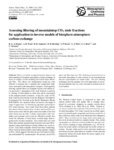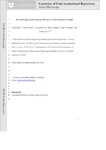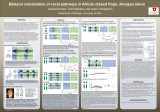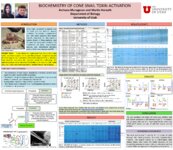|
|
Creator | Title | Description | Subject | Date |
| 26 |
 |
Sperry, John S. | Analysis of circular bordered pit function II. Gymnosperm tracheids with torus-margo pit membranes | A model of xylem conduit function was applied to gymnosperm tracheids with torus-margo pit membranes for comparison with angiosperm vessels. Tracheids from 17 gymnosperm tree species with circular bordered pits and air-seed pressures from 0.8 to 11.8 MPa were analyzed. Tracheids were more reinforced... | Functional wood anatomy; hydraulic architecture; plant biomechanics | 2004 |
| 27 |
 |
Beckerle, Mary C. | Analysis of the roles of microtubules and actin in erythrophore intracellular motility | The Holocentrus erythrophore, a red pigment cell, represents a model system for the study of organized intracellular transport. We have investigated the possibility that microtubules and actin are integral components of the pigment translocating motility machine. | Actin; Actomyosin; Erythrophore; Pigment | 1983 |
| 28 |
 |
Sperry, John S. | Anatomy of the palm Rhapis excelsa, IX. Xylem structure of the leaf insertion | STEMS OF PERENNIAL PLANTS, particularly trees, represent a considerable investment in biomass. Trees can survive even under the most adverse conditions, but only if the hydraulic integrity of the stem is preserved. A very important and vulnerable part of the stem is the xylem. As water is pulled int... | Palm stems; Palm stem anatomy; Palm leaves; Leaf insertion; Vessel network; Vessel-length distribution; Primary vascular stem tissue; Hydraulic architechture; Water column | 1983 |
| 29 |
 |
Sperry, John S. | Anatomy of the palm Rhapis excelsa, VIII. Vessel network and vessel-length distribution in the stem | THE CONCEPT of the vessel, a conducting unit consisting of a series of vessel elements lined up end to end, has been known for well over a century (e.g., Hartig, 1878). The fact that vessels are of limited length is of considerable functional importance. If a vessel is damaged (for example, by an in... | Palm stems; Palm stem anatomy; Vessel network; Vessel-length distribution; Primary vascular stem tissue; Hydraulic architechture; Water column | 1982 |
| 30 |
 |
Davidson, Diane W. | Ant-plant symbioses in Africa and the neotropics : history, biogeography and diversity | Symbiotic ant-plant relationships afford an excellent opportunity to analyze the effects of both historical and ecological factors on the evolution of mutualisms. Occurring in tropical forests throughout the world, all myrmecophytic plants provide food and permanent housing to ants; the ants, in t... | Ant-plant symbiosis; Africa; Neotropics; Myrmecophytes; Plant-ants | 1993 |
| 31 |
 |
Coley, Phyllis D. | Antifungal depsidone metabolites from Cordyceps dipterigena, an endophytic fungus antagonistic to the phytopathogen gibberella fujikuroi | Among thirty four endophytic fungal strains screened for in vitro antagonism, the endophytic fungus Cordyceps dipterigena was found to strongly inhibit mycelial growth of the plant pathogenic fungus Gibberella fujikuroi. Two new depsidone metabolites, cordycepsidone A (1) and cordycepsidone B (2), w... | | 2012 |
| 32 |
 |
Bowling, David R. | Assessing filtering of mountaintop CO2 mole fractions for application to inverse models of biosphere-atmosphere carbon exchange | There is a widely recognized need to improve our understanding of biosphere-atmosphere carbon exchanges in areas of complex terrain including the United States Mountain West. CO2 fluxes over mountainous terrain are often difficult to measure due to unusual and complicated influences associated with ... | | 2012-01-01 |
| 33 |
 |
Beckerle, Mary C. | Atrial natriuretic peptide promotes cardiomyocyte survival by cGMP-dependent nuclear accumulation of zyxin and Akt | This study delineates a mechanism for antiapoptotic signaling initiated by atrial natriuretic peptide (ANP) stimulation leading to elevation of cGMP levels and subsequent nuclear accumulation of Akt kinase associated with zyxin, a cytoskeletal LIM-domain protein. Nuclear targeting of zyxin induces r... | Zyxin; Akt; Cyclic guanosine monophosphate | 2005 |
| 34 |
 |
Gesteland, Raymond F.; Ives, Jeffrey T.; Stockham, Thomas G. | Automated film reader for DNA sequencing based on homomorphic deconvolution | An automated reader for electrophoresis based DNA sequencing methods is described that provides fast and accurate sequence determination. Digitized sequencing lanes are processed with homomorphic blind deconvolution in preparation for peak detection, interlane alignment, peak refinement and base cal... | Sequence Analysis; Electrophoresis; Automated Film Reader; Homomorphic Deconvolution | 1994 |
| 35 |
 |
Jorgensen, Erik | Axon regeneration genes identified by RNAi screening in C. elegans | Axons of the mammalian CNS lose the ability to regenerate soon after development due to both an inhibitory CNS environment and the loss of cell-intrinsic factors necessary for regeneration. The complex molecular events required for robust regeneration of mature neurons are not fully understood, part... | | 2014-01-01 |
| 36 |
 |
Jorgensen, Erik | Axons break in animals lacking B-spectrin | Axons and dendrites can withstand acute mechanical strain despite their small diameter. In this study, we demonstrate that β-spectrin is required for the physical integrity of neuronal processes in the nematode Caenorhabditis elegans. Axons in β-spectrin mutants spontaneously break. | | 2007 |
| 37 |
 |
Bastiani, Michael | Axons break in animals lacking β-spectrin | Axons and dendrites can withstand acute mechanical strain despite their small diameter. In this study, we demonstrate that β-spectrin is required for the physical integrity of neuronal processes in the nematode Caenorhabditis elegans. Axons in β-spectrin mutants spontaneously break. | Mutants; Dendrites; Morphology | 2007 |
| 38 |
 |
Hughes, Kelly T. | Bacterial flagellin-specific chaperone FliS interacts with anti-sigma factor FlgM | Flagella are extracellular organelles that propel bacteria. Each flagellum consists of a basal body, a hook, and a filament. The major protein of the filament is flagellin. To prevent premature polymerization of newly synthesized flagellin molecules, FliS, the flagellin-specific chaperone, binds fla... | | 2014-01-01 |
| 39 |
 |
Olivera, Baldomero M. | Bacteriophage Mu DNA replication in vitro | An in vitro system for bacteriophage Mu DNA replication using lysates on cellophane discs is described. Mu replication was monitored by DNA hybridization. Using a thermoinducible Mu Iysogen, 30-50% of all DNA synthesis in vitro was Mu-specific. | Bacteriophage Mu | 1983 |
| 40 |
 |
Adler, Frederick R. | Balance of terror: an alternative mechanism for competitive trade-offs and its implications for invading species | This article uses models to propose an explanation for three observations in community ecology: the apparent overreaction of prey to attack by specialist predators, the existence of a common trade-off among components of competitive ability in communities of unrelated competitors, and the ability of... | Models; Curve; Native | 1999 |
| 41 |
 |
Ehleringer, James R. | Bayesian integration of isotope ratio for geographic sourcing of castor beans | Recent years have seen an increase in the forensic interest associated with the poison ricin, which is extracted from the seeds of the Ricinus communis plant. Both light element (C, N, O, and H) and strontium (Sr) isotope ratios have previously been used to associate organic material with geographic... | | 2012-01-01 |
| 42 |
 |
Coley, Phyllis D. | Beneficios y costos de defensa en un arbusto del neotrópico | LOS beneficios y costos son de importancia capital para las teorfas de optimization de las defensas de las plantas. El beneficio es la ganancia de aptitud para reducir el herbivorismo; el costo es la perdida de aptitud al comprometer recursos en defensa. Evaluamos los beneficios y los costos de def... | Psychotria horizontalis; Isla de Barro Colorado; Costos de defense; Celdas de exclusion; Herbivorismo; Defensa de las plantas; Taninos; Dureza; Tropicos; Benefit; Beneficios | 2007 |
| 43 |
 |
Coley, Phyllis D. | Benefits and costs of defense in a neotropical shrub | Benefits and costs are central to optimality theories of plant defense. Benefit is the gain in fitness to reducing herbivory and cost is the loss in fitness to committing resources to defense. We evaluate the benefits and costs of defense in a neotropical shrub, Psychotria horizontalis. Plants were ... | Cost of defense; Growth-defense trade-off; Exclosures; Field experiment; Herbivory; Panama; Psychotria horizontalis; Rubiaceae; Tannins; Toughness; Tropics | 1995 |
| 44 |
 |
Coley, Phyllis D. | Between-species differences in leaf defenses of tropical trees | Rates of herbivory and patterns of leaf defense are presented for light-demanding and shade-tolerant tree species growing in a lowland rainforest in Panama. More than 85 percent of the annual leaf damage is due to grazing by insects. There are over three orders of magnitude difference between specie... | Herbivory; Interspecific variation; Panama; Growth rate; Shade tolerance; Treefall gaps; Tropical forest; Understory; Tannins; Alkaloids | 1987 |
| 45 |
 |
Yamaguchi, Ayako | Bilateral coordination of vocal pathways in African clawed frogs, Xenopus laevis | This poster describes how bilateral coordination of motor programs are achieved in the central vocal pathways of African clawed frogs. | Vocalizations; Central pattern generator; Motor programs; Bilateral coordination | 2014 |
| 46 |
 |
Goller, Franz | Bilateral syringeal contributions to song in the zebra finch | Although central control of song production has been investigated extensively in the zebra finch (Taeniopygia guttata), much less is known about peripheral vocal motor dynamics during song. | Electromyographic activity; Sound souces; Unilateral | 2004 |
| 47 |
 |
Beckerle, Mary C. | Biochemical and molecular characterization of the chicken cysteine-rich protein, a developmentally regulated LIM-domain protein that is associated with the actin cytoskeleton | LIM domains are present in a number of proteins including transcription factors, a protooncogene product, and the adhesion plaque protein zyxin. The LIM domain exhibits a characteristic arrangement of cysteine and histidine residues and represents a novel zinc binding sequence (Michelsen et al., ... | Zyxin; Cysteine-rich proteins; cCRP; Actin; LIM domains | 1994 |
| 48 |
 |
Olivera, Baldomero M. | Biochemical characterization of ?M-RIIIJ, a Kv1.2 channel blocker: evaluation of cardioprotective effects of ?M-conotoxins | Conus snail (Conus) venoms are a valuable source of pharmacologically active compounds; some of the peptide toxin families from the snail venoms are known to interact with potassium channels. We report the purification, synthesis, and characterization of ?M-conotoxin RIIIJ from the venom of a fish-... | | 2010 |
| 49 |
 |
Olivera, Baldomero M. | Biochemical studies of ω-conotoxin GVIA; a peptide toxin inhibiting voltage-sensitive Ca++ channels | The fish-hunting cone snails use their venom to quickly paralyze their more agile prey. In the last few years, our laboratories have carried out a program of analyzing biologically active components present in the fish-hunting cone snail venoms (Cruz et al. 1985; Olivera et al. 1985). We have concen... | Conotoxins; Calcium channels; Conus geographus; Venom | 1987 |
| 50 |
 |
Horvath, Martin P. | Biochemistry of Cone Snail toxin activation | Cone snails use venom to capture prey for food and for defense against predators. The venom is composed of over 100 active peptides that target specific receptors in the nervous system. Several of these peptides have the potential to become medicine for treatment of pain, depression, seizures, and n... | biochemistry; horvath; olivera; cone snail; toxin; nmda; elution; buffers; sparse matrix test; protease; protein; purification; neurotoxin; conotoxin | 2013 |

























